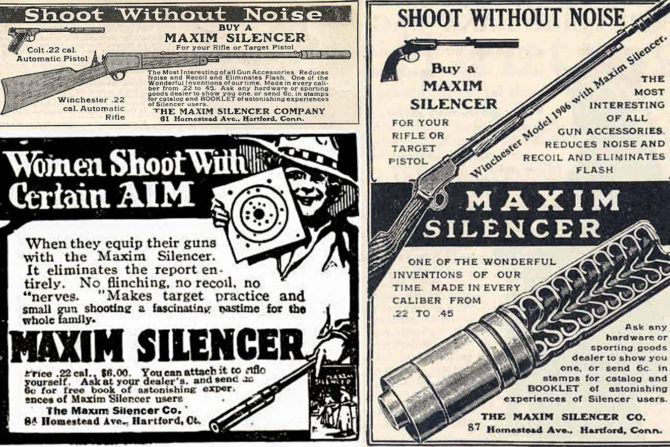
A SAFETY DEVICE DESIGNED TO PROTECT OUR HEARING THAT WAS DEMONIZED AS BEING A TOOL FOR MURDERERS, THIS IS A WILD RIDE.
Editor’s Note: A shortened version of this article was published in RECOIL issue #61. This is the full story.
Today the oft-repeated gun shop lore is that up until 1934 when the National Firearms Act passed, silencers were sold widely via mail-order in the Sears Catalog for $5 or $10 — but their use in poaching during the Great Depression and by gangsters during Prohibition caused manufacturing of the harmless hushpuppies to vanish overnight.
Like so many urban legends, there are half-truths and holes in that narrative. Not to mention the dates don’t line up.
Alcohol prohibition, with its unintended consequences of organized — and violently weaponized — crime, didn’t take place until 1920. And by that time, many states had already banned silencers.
The Prohibition-fueled crime wave wasn’t the impetus against them.
Similarly, the Great Depression ran between August 1929 and March 1933. Poaching deer quietly to feed one’s starving family would, indeed, make a palatable explanation for why silencers might be under scrutiny.
However, Maxim’s company had already voluntarily exited the silencer business by the spring of 1930 because the sale or use of their namesake product was banned by many states years earlier.
The NFA most certainly didn’t put Maxim out of business overnight; he had already been long chased out of it. All the 1934 NFA law did was merely tie up a two-decade-old anti-silencer period in history with the neat bow of federal homogenization.
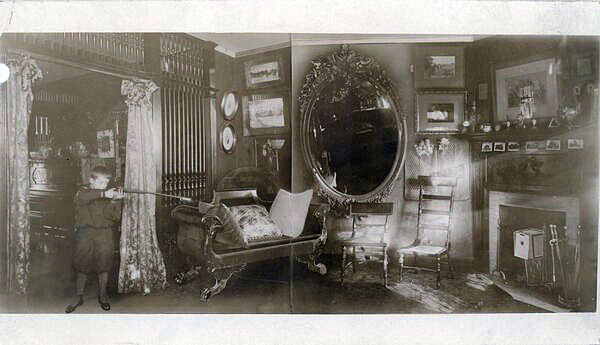
BURN THE WITCH
When the silencer was initially invented in 1902, it was enthusiastically admired, then quickly misunderstood and consequentially feared.
For a short moment, Maxim’s creation was hailed in the common press as a wonder as worthy as those made by Edison, Ford, Tesla, Westinghouse, and the like during that particularly yeasty time in American ingenuity. But newspaper articles turned speedily from admiration to terror.
It didn’t take long for panicked politicians to envision “the silent killer” would become a widespread worry. And there were, admittedly, a handful of high-profile crimes in the early 1900s to touch off the anti-silencer hysteria.
Though some people will do bad things regardless of the tools they choose to commit them, the novelty of the few crimes committed while using silencers was enough to fuel the uneducated public’s fears.
The first notable case was the horrifying account of Herman Auerbach. Heir to a very wealthy New York candy-manufacturing family, he had sold his share of the business, bet his fortune heavily on real estate investments, and lost big.
Depression led him down a dark path, with Auerbach succumbing to, what the New York police determined was “temporary insanity, brought on by imminent poverty after a life of prosperity”. On the Sunday night of January 31, 1915, his depression finally culminated in his own suicide — and because he was extra awful, the murder of his own wife and children.
While this would be a titillating tragedy for the newspapers to report all by itself, the next morning’s Evening World newspaper’s bold, all-caps headline led with an unusual twist: “USED GUN SILENCER TO MURDER THREE AND KILL HIMSELF.”
The article reported that Auerbach’s second wife and his two “pretty daughters” were killed using a rifle loaded with “dum-dum bullets,” adding to the gory contrast of the scene.
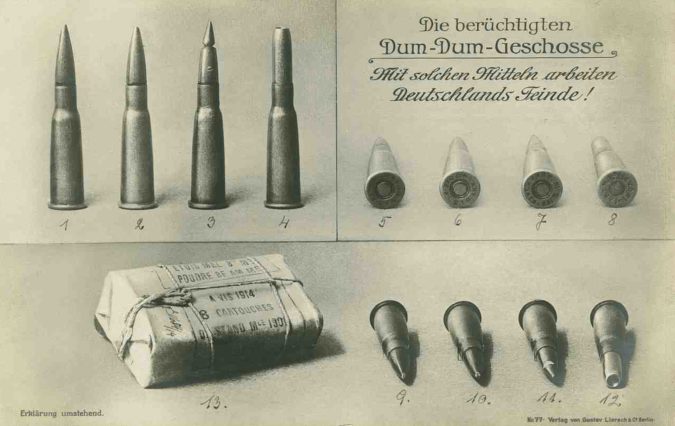
The final horror for readers was how his 14-year-old son was left alive to discover the carnage. He was sleeping in a bedroom directly abutting the room where his sister was shot in the head.
A Maxim silencer screwed to the end of the .44 caliber magazine-fed rifle used by Auerbach was said to ensure the son stayed asleep while unspeakable murder took place only a wall apart. All this took place in a many-neighbored New York apartment, with no one hearing the slaughter.
But could four suppressed gunshots, the firearm’s action, and bullet impact noises be so silent that they weren’t even heard through a thin wall a mere foot or so away?
The silencer’s inventor, Hiram P. Maxim, himself may have had trouble believing it. Regardless, he certainly saw the need to quickly counter the police commissioner’s immediate calls for an ordinance that would prevent the sale of silencers.
By February 10, a week after the murders, Maxim ended up coming to New York to demonstrate his silencer in the basement of the police headquarters. The inventor “showed the device to be ineffective on the ordinary revolver and by no means a complete silencer on a rifle.”
Using the actual rifle Auerbach committed his crimes with, Maxim and his uncle Hudson came to prove to the police commissioner, district attorney, and other officers that the gun’s report, although diminished in volume, was unmistakable for anything else than that of a gun.
Regardless of whether a silencer was actually used or not, the blame continued falling on the firearm, the unusual ammo, and the silencer, rather than on the man who had premeditatedly pulled its trigger.
The February 1st edition of the New York Times hammered this home with an even more tool-shaming headline that would lead readers to believe that all four persons were victims and only the gun was the antagonist: “SILENT GUN KILLS A FAMILY OF FOUR.”
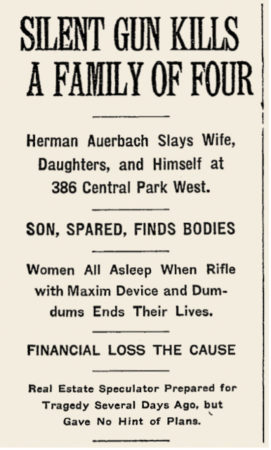
Headlines like this made New York State Senator Irving J. Joseph so aghast that, only two days later, on February 3, 1915, he introduced his bill to make it a felony to sell a silencer in New York.
There were other crimes involving silencers that caught the public’s fascination during this era.
A year after the Auerbach tragedy, Albany, New York, was terrorized by Harold L. Severy, a young man who had a local machine shop fashion a sleeve gun he concealed in his overcoat. His Stevens firearm also had a Maxim muffler mounted to its muzzle.
Severy’s own father claimed, “I think there is no doubt my son is deranged.” Six years prior, his son had suffered a head injury during a hazing incident as an art student in Boston.
The brain damage resulted in his being sent to two sanitariums. Severy escaped, later surfacing to throw the city of Albany into a week of uneasy fear after he stalked and shot four random persons in the back on a Friday night in January 1916.
Strangely, since they didn’t hear a gunshot, each of the stalker’s prey continued walking along their way. As they each were shot only once with the diminutive .22 caliber round, it “felt like a sharp sting,” but apparently being shot by the low-powered round didn’t warrant stopping.
The Advertiser-Journal of January 29, 1916 wrote that, ”None of them knew they were wounded until being examined by physicians.” The day prior, two women believed they had also been shot at by a youth with an air rifle because they hadn’t heard a gunshot either.
The entire police department began searching for the would-be assassin, and a well-dressed youth was soon arrested.
Even though, as The Argus newspaper reported, Severy was “…possessed of the far-away look, which showed the authorities that his mind was off,” Senator Joseph again wasted neither time nor tragedy in pushing his pet plan to criminalize silencers in New York.
On February 2, 1916, just a day after Severy’s arrest and almost a year to the day since his last bill’s attempt to ban silencers, Senator Joseph and Assemblyman John Malone advanced their bill that would make it a felony to sell any silencer, punishable by five years of imprisonment.
The bill was passed only a month later. It was then signed into law by Governor Whitman on April 6, 1916.
This law prevented New Yorkers access to legal firearm-mounted hearing protection — and began cueing up Maxim’s exit from the rapidly shrinking, highly restricted market.
But, like most laws that attempt to prohibit a behavior by banning an item, it didn’t stop human nature.
New York’s laws grew more anti-gun with the passage of their Sullivan Act, named for its sponsor, state senator Timothy Sullivan, a notoriously corrupt politician.
It made it a felony for otherwise law-abiding New Yorkers to possess or purchase small handguns and other weapons unless they petitioned and paid the government for permission to do so.
Human nature being what it is, underground markets sprung up and now possession alone became the criminal act, rather than actual violence.
The initial purchasers of silencers were overwhelmingly law-abiding sportsmen. But that pool of users was now artificially prevented from buying them.
Like today’s illegal narcotics market has shown, the sort of person who’s willing to break one law might also have a proclivity to ignore others. Prior to this date, many people from all walks of life might prefer shooting quietly.
But from this point in time, the only news reports written about silencers would of course involve criminal use.
A high-profile example of this occurred in 1924. Eugene Reising, who later went on to firearms-fame as the inventor of the Reising M50 submachinegun, once was arrested for violating the Sullivan Act.
His crime was selling some Maxim silencers to the “Cowboy” Tessler Gang, whose members were charged with 81 holdups and at least one murder.
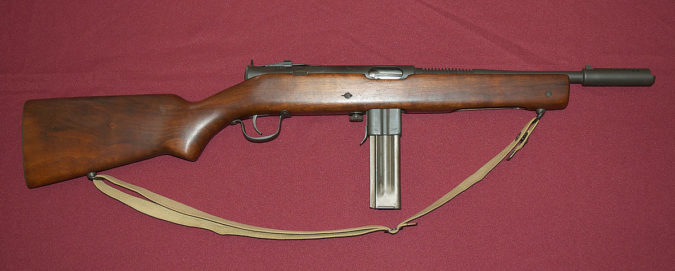
Reising served 15 months jail time, but apparently wasn’t prevented from returning to the arms trade any more than banning silencers and firearms had stopped the Cowboy Tessler gang from obtaining them.
Like New York, many individual states and cities had banned the silencers outright well before the NFA’s ban-by-taxation scheme was hatched. Anti-silencer laws had been passed a decade or more prior in many of the 48 individual states.
Some were hunting-based, some required registration, others simply banned the item’s possession, manufacture, or sale without explanation or cause.
In Maine’s case, the irony was thick. It was the state of Maxim’s father’s birth. It was the first state in the U.S. to pass their own alcohol prohibition in 1851. And it was also one of the first states to enact prohibition of the Maxim family’s silencers.
Maine introduced a law in 1909, the same year Maxim’s silencer patent was issued — “An Act to prohibit the use of Firearms fitted with any device to deaden the sound of explosion, Ch. 129, § 1.”
It reads:
“It shall be unlawful for any person to sell, offer for sale, use or have in his possession, any gun, pistol or other firearm, fitted or contrived with any device for deadening the sound of explosion. Whoever violates any of the provisions of this act shall forfeit such firearm or firearms and the device or silencer, and shall further be subject to a fine not exceeding $100, or to imprisonment not exceeding 60 days, or to both fine and imprisonment.”
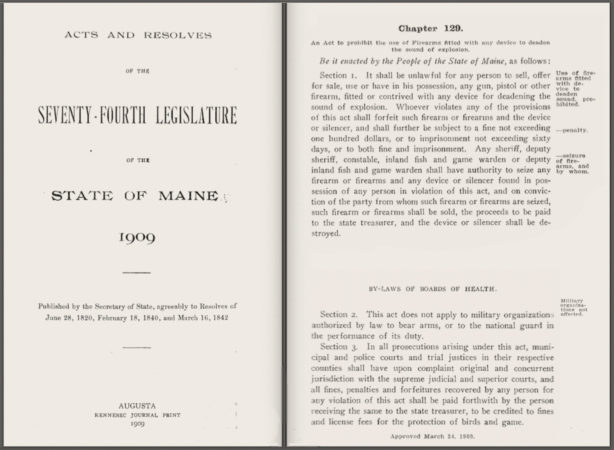
One could make a case that the impetus of the Maine law wasn’t any concern of violent crime.
Chapter 130 of their 1909 law says that, “Any sheriff, deputy sheriff, constable, inland fish and game warden or deputy inland fish and game warden shall have authority to seize any firearm or firearms and any device or silencer found in possession of any person … and all fines, penalties and forfeitures recovered by any person for any violation of this act shall be paid forthwith by the person receiving the same to the state treasurer, to be credited to fines and license fees for the protection of birds and game.”
Similarly, Wyoming’s first 1921 anti-silencer law is an afterthought buried behind 58 pages of wildlife codes mandating mundane things such as the size of red bandanas to be worn in hunting fields, how deer tags are issued, and regulations on the use of hunting dogs.
It seems there was no worry there about violent crime, but rather concerns over what hunting firearms were deemed “sporting” enough.
North Carolina’s 1925 law was solidly based on hunting concerns, even calling out Hiram’s brand by name. “It shall be unlawful to trap for bear or to run or hunt deer with dogs or to use while hunting any gun having a ‘Maxim silencer’ or any other device thereon that will muffle the report of such gun, nor shall any gun be used that does not produce when discharged the usual and ordinary report.”
Following Maine, there were anti-silencer and anti-silencer hunting laws put on the books in Vermont (1912), Minnesota (1913), Michigan (1913), New York (1916), New Jersey (1920), Wyoming (1921), Pennsylvania (1923), North Carolina (1925), Massachusetts (1926), Rhode Island (1927), California (1933), and other jurisdictions and cities.
While some laws were clearly rooted in trying to hold back modern advancements in hunting technology, some of these states’ early anti-silencer laws exempted the police and military.
Clearly, that aspect wasn’t included for hunting. The silencer was introduced by Maxim for sporting purposes, but military use was certainly also envisioned. The states that included language exempting government use clearly feared crime and warfare.
Pittsburg’s 1909 decry against silencers has some of the earliest recorded police backing. It also shows there was literally nothing other than fear motivating the law. “The matter was brought to the notice of the police department by a citizen, who pointed out the almost unlimited opportunities for crime presented in the use of the ‘silencer.’”
While the writings of the time admitted that handguns are seldom used by highwaymen robbers, it was hypothesized that criminals would be tempted to use their firearms more often if they were quieter. This law wasn’t based on any evidence, only one citizen’s worry of what “could be.”
The words of a police superintendent from a major metropolis must carry some weight; in a press conference, one man merely opining that silencers “will prove disastrous to the peace of every city where precautions against its use are not taken” was apparently enough “proof” to get laws on the books. Pittsburg’s policy was based entirely on conjecture.
The penalty for possession of a muffler in Pennsylvania was to be greater than possession of an actual firearm.
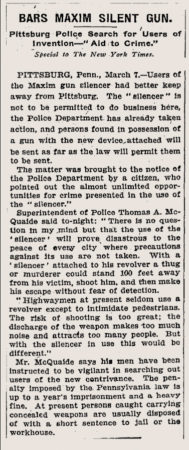
Vermont’s 1912 law clearly spelled out that their goal was to “Prevent the Manufacture, Sale, or Use of Gun Silencers.”
It was clearly of the nature that envisioned violent crime, as it exempted military purposes, and contained no language concerning hunting.
Massachusetts’ 1926 law also follows in those prejudicial footsteps. Boston’s Police Commissioner, Herbert A. Wilson, lobbied for legislative action to “prevent the sale or use of silencers.”
He mentioned the devices had “recently been used in other cities” and that “legislation is necessary to assist the police in apprehending offenders who use this device in the commission of crime.”
Specifically mentioning use outside the Commonwealth, and having no valid examples that occurred in Massachusetts itself, he may have been referring to the two New York incidents of over a decade prior.
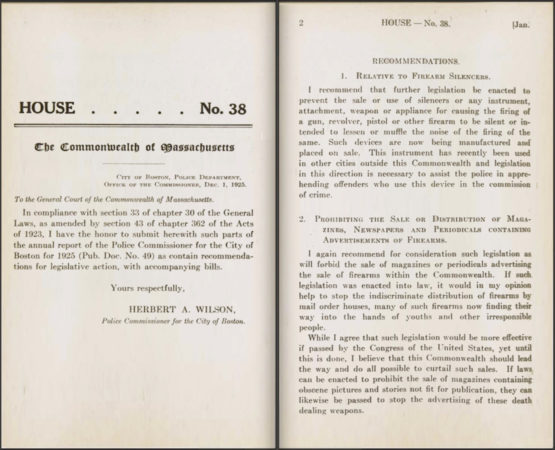
Just like some states’ hypothesis that silencers could be used in violence, there was a federal fear that silencers might be used against the U.S. in wartime.
This happened in Texas, where Mexican nationals shot at Texas militiamen that were guarding the El Paso Electric Light Plant in the late hours of March 1, 1912 from the Mexico side of the border — using Maxim silencers. This made for some interesting conclusions where one might not expect them.
President Woodrow Wilson, in his 1917 announcement of war between the U.S. and Germany, gave warnings to Germans residing in the United States. Wilson instructed they must “keep the peace” and gave a list of twelve regulations to these resident aliens/potential enemies.
In an important, national address, the very first regulation on the President’s list specifically called out silencers:
“An alien enemy shall not have in his possession at any time or place any firearms, weapons or implements of war or component parts thereof, ammunition, maxim [sic] or other silencer.”
HUNTERS, GAME WARDENS, AND RACISTS: UNITED AGAINST SILENCERS
The sportsman’s community of the day was divided in debate over this new invention.
Some were like President Teddy Roosevelt, who had no problem attaching Maxim silencers onto his well-known Winchester hunting rifles, embracing the pleasant relief from noise pollution while others distained the devices. Just like today, hunters of the 1900s comprised a complex, diverse group of individuals.
Some were content to wipe out the bison and other species wholesale, while others were careful conservationists.
A segment of hunters saw any new tool or advancement making the hunt “easier” as a cheat. Better scopes, for instance, were nothing but an unfair trick and using an automobile to get closer to game was viewed as an evil by some.
Silencers were lumped into a class of “unsportsmanlike” products by Luddite, hyper-conservative hunters.
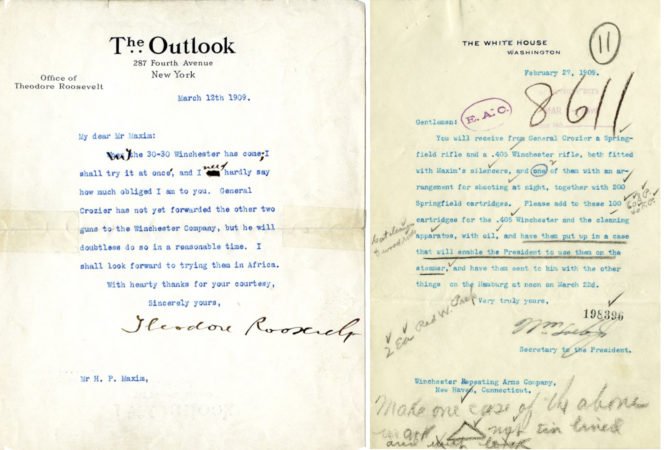
The media again played a part in advancing the negative narrative.
An opinion piece published in the 1909 New York Times illustrates some hunters and hunting organizations of the day’s view on the controversial cans.
“Who needs a silencer? The Black Hand (an immigrant extortion and kidnapping gang) assassins, but surely not a sportsman!”
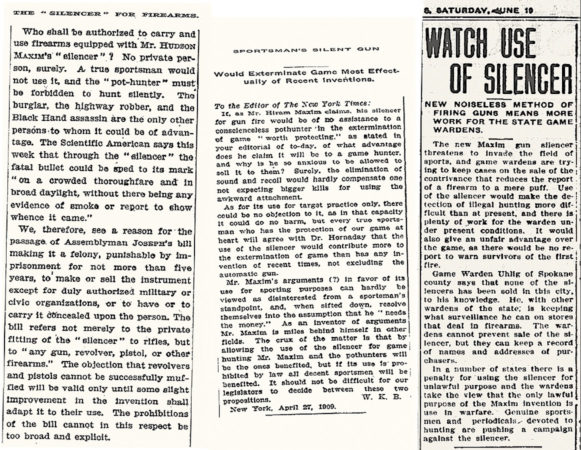
Like today, there were “Fudds” that offered up these evil devices as sacrificial lambs to the growing anti-gun movement. Some hunters were willing to do so because silencers did not affect their kind of rifles or their kind of hunting.
William T. Hornaday, an influential conservationist who served as the director of the Bronx Zoo and once actually put a black Congolese man on display in a cage, was enthusiastic about banning modern firearms of all sorts — often as a hand-in-hand move to advance his openly racist and classist views of keeping minorities, immigrants, and low-class white people out of the “better classes’” hunting fields.
His views not only limited to silencers themselves, Hornaday espoused some equally cringe-worthy and conflicting views on gun control.
He advanced the idea that concealed handguns were perfectly acceptable to defend against the lower classes and races. But, as the Washington Post reported, “In the South, Hornaday argued, the problem was hunting by “poor white trash” and blacks ….”
Hornaday argued that all pump-action guns should be banned, as should all semi-automatics and all “silencers.” In his 1913 book Our Vanishing Wildlife: Its Extermination and Preservation, he blamed the decimation of wildlife on not only automobiles, but black people, immigrants, and the poor.
Modern arms were too accurate, having newfangled optics and advancements that made killing animals too easy. Hornaday made a table of sorts, attempting to rank the “increase in the deadliness of firearms”. The “Repeating rifle, with silencer” was his list’s third-most deadly gun.
It was deemed a bit less concerning, however, than his top two: the pump shotgun, and the worst of them all, the five-round autoloading shotgun.
He urged new laws to “prohibit the use of firearms by any naturalized alien from southern Europe until after a 10-years’ residence in America.” Wildlife was vanishing because “the Italians are spreading, spreading, spreading.
If you are without them to-day, to-morrow they will be around you. Meet them at the threshold with drastic laws, thoroughly enforced.” One such drastic law he may have influenced was the National Firearms Act of 1934.
THE NATIONAL FIREARMS ACT: ONE MORE NAIL IN THE CAN’S COFFIN
The National Rifle Association wrote an article on the Maxim silencer, stating “In 1934, the National Firearms Act (NFA) was implemented as a means to restrict and regulate certain firearms and devices.
This included a heavy $200 tax on suppressors, essentially halting development for 40 years.” But as we know, the silencer had already been demonized by the 1920s and almost squeezed out of existence for public sale in many states well prior to the 1934 law.
Stephen Halbrook’s Law Review article on the inclusion of silencers into the NFA points out that, “Astonishingly, no facts or data were ever set forth in the legislative record suggesting that suppressors were a crime problem” and in the Hearings in the House of Representatives on the National Firearms Act account of the lawmaking, politicians were willing to ban silencers with “…not one word … uttered about any need to restrict noise suppressors.”
In a recent article questioning why silencers were lumped into the NFA, The Washington Post stated, “In the legislative history, there was no discussion of ‘silencers.’ We simply have no idea what (if anything) Congress thought it was doing about them.”
But perhaps we do have an idea. By the time the 73rd Congress debated the proposed NFA in the spring of 1934, silencers were already long vilified enough to be a lost cause. It was common understanding that silencers were simply an item to be added to this new federal list along with other firearms established as “bad”.
The most unsurprising person to throw in the towel on silencers was its inventor. Long prior to the NFA being implemented in 1934, Maxim and his company gave in to public pressure by ending production.
Through the years, we can observe Maxim’s continued attempts to educate a fearful populace and politicians alike that silencers were positive and were not the evil some contended. Maxim’s attempts to illustrate the benefits of silencers outweighing fear and conjecture fell on deaf ears.
Hiram Maxim and his representatives planned and embarked on educational tours at gun ranges, stretching from the eastern seaboard all the way to Hawaii.
They tried at every opportunity to show what silencers did (and didn’t) do. Maxim took it upon himself to educate law enforcement that they did not enable crime, and that they were far from completely silent, as reported. They sponsored shooting events, giving prizes to winning shooters that utilized a silenced rifle.
Finally, the Maxim family took to writing rebuttals in periodicals that had lambasted the silencer.
While newspaper opinion pieces are open for anyone to spew their conjecture — and Maxim sometimes countered these — academic publications were prone to the same fear-based advocacy as well.
Probably the most damaging article ever written against the silencer ran in the Scientific American journal. In the February 20, 1909 issue, the author stuck to the facts and wrote matter-of-factly about Maxim’s new invention and how silenced firearms would benefit soldiers.
But by March, fear yet again took over. The follow-up piece “The Menace of The Noiseless Gun,” left science behind for propaganda absent of fact. It led as the premiere column in the March 20, 1909 issue.
The accusatory article theorized that, “Not even the cover of night will be necessary for the concealment of deeds of violence. The fatal bullet can be sent to its mark on a crowded thoroughfare and in broad daylight, without there being any evidence of smoke or report to show whence it came … The deadly character of the noiseless gun renders it, in the hands of the unscrupulous people, a distinct menace to society.”
Hudson Maxim, uncle to Hiram, was inspired to write corrections to these claims. Some rebuttals were filled with science: highlighting the fact that supersonic cracks of the projectiles still existed and that Maxim’s silencers couldn’t silence the revolvers favored by criminals at the time.
Hudson Maxim pointedly penned, “The limitations of the silencer are not at all understood by the ordinary public nor the ordinary newspaper writer anxious to build a good story …” He actually doubts that Auerbach even used the silencer in his crime. Hudson wrote that “…at close range (the silencer) would have left very conspicuous marks on the victims.
There were no marks on the bodies nor in the rooms as far as I could find out, which throws grave doubts upon the use of the rifle with the silencer.”
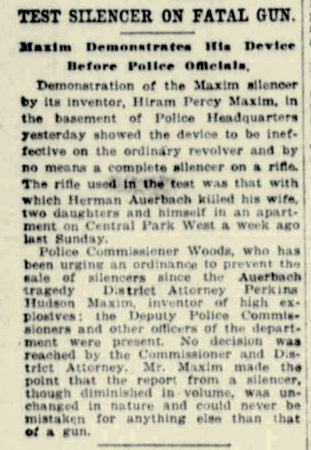
As a final petition, Hiram Maxim appealed to his highest-placed fan, President Teddy Roosevelt, asking for help as he watched his invention damned at every turn.
But while Roosevelt may have personally enjoyed shooting his suppressed Winchesters, policy was not something he was willing to tackle on his behalf.
In a faded letter from the president to Maxim dated March 18, 1915, he sends his pro-silencer regrets:
“…My sympathies are with your side of the case; and I should think that from the military standpoint it would be very unwise for me to prohibit the use of silencers, unless others did it. I do not, however, know enough about the matter to give you a definite judgement. With real regret, Sincerely yours, Theodore Roosevelt.”
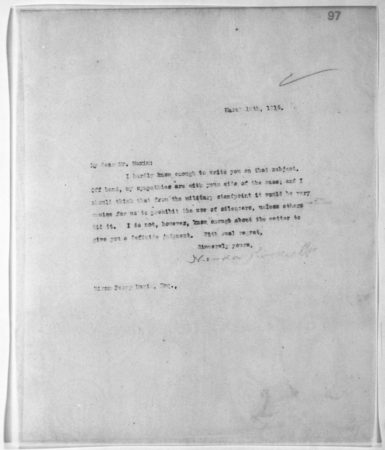
By May 7, 1930, it was reported in many U.S. newspapers that Maxim’s company board had decided to abandon the defense of his invention.
“Yielding to the public opinion that the manufacture of gun silencers … helps aggravate crime condition, the company has decided to discontinue the manufacture of silencers for firearms.”
The press further noted that Mr. Maxim was taking a break from America and heading to Europe after only selling 2,500 or so silencers into the U.S. civilian marketplace.
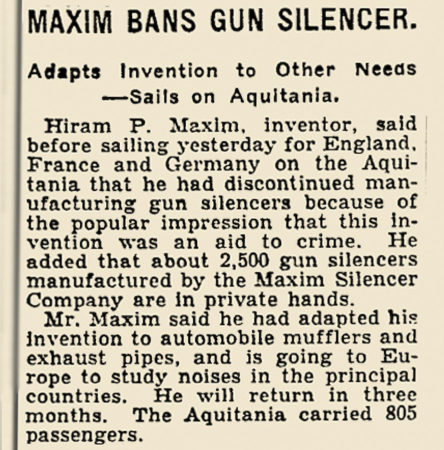
Perhaps Maxim had tired of the narrow-minded witch hunt of politics and, like his father, found Europe as a welcome escape.
Even though firearms are more restricted there, most European countries have reached the conclusion that non-firearm accessories like silencers are not the evil some declare. As Halbrook notes, “The more liberal approach to suppressor ownership in Europe suggests that it is not the crime problem it is perceived to be in the United States.”
The use of stolen machineguns by a handful of high-profile criminals in the wake of Prohibition-fueled robberies led to a call for federal action to protect the populace from these “public enemies.” Unusual firearms and silencers were lumped in when these catch-all, anti-gun laws were written.
In 1975’s The Gun in America: The Origins of a National Dilemma Lee Kennett wrote, “The clamor for federal action coincided with the advent of the New Deal, an administration resolved to mobilize the full power of the national government and direct it at a whole range of besetting problems … Franklin D. Roosevelt’s newly appointed Attorney General, Homer Cummings, announced in the summer of 1933 that existing laws on pistols were woefully deficient. He and his staff began the preparation of a dozen anti-crime bills, including a proposed National Firearms Act.”
It was unconstitutional to ask for an outright ban on any firearm but taxing them to death was an achievable goal. Adjusted for inflation, the $200 tax to transfer a $6 silencer in 1934 dollars would be equivalent to ~$4,200 tax on a ~$320 item in 2022. The law clearly had no real revenue incentive, but that was the subterfuge used to push it across the legislative goalposts.
The National Firearms Act’s clearly stated (but not achieved) main goal was to ban the pistol. Items like machineguns and silencers were tossed in without much debate, and, as Hallbrook claims “were subjected to the provisions of the National Firearms Act in 1934 without evidence of significant criminal misuse, and the restrictions were extended without further thought when the NFA was revised in the Gun Control Act of 1968.”
By 1934, many prejudiced politicians of the day just “knew” that anyone in possession of a silencer was guilty–without need for due process, warrant, or charges brought against them.
This attitude can be seen in the testimony of the Representative from Arkansas, Claude Fuller, in his affirmation of Cummings: “If a man is carrying (a silencer), if he is not an officer, he ought to be taken into custody anyway, because we know that he is carrying it for an unlawful purpose.”
Ironically, the representative from Arkansas should have been aware of the recent unwarranted arrest of two brothers from his state — peacefully retired investment bankers — who were chased and taken into custody by overzealous and heavily armed police as they drove home through Texas because a local policeman thought he’d spotted the notorious gangster, George “Machinegun” Kelly.
The officer’s poor judgement turned into a dangerous pursuit. After being held at gunpoint, their car was searched without warrant and a large sum of money and a completely legal rifle with silencer were discovered and confiscated. Despite the local police chief being “certain neither man was Kelly.”
Thankfully, the wrongful arrest didn’t amount to anything worse than being “downright annoying” and “embarrassing,” but the bigoted Representative’s attitude-in-action was clearly as risky as it was inconvenient for the innocent brothers.
At worst, legislators were this prejudiced. At best, any potential defender allowed to speak on the silencer’s behalf was either unaware — or duplicitous — of the public health benefits and other legitimate purposes of it. This sort of blind-leading-the-blind lawmaking echoed throughout the following years as anti-silencer legislation advanced.
The ignorance and dishonesty of government officials is perhaps illustrated best in the exchange between the Congressman Hughes and BATFE Director Higgins during the 1984 House of Representatives hearing on “Armor Piercing Ammunition and The Criminal Misuse and Availability Of Machineguns And Silencers” that led up to the United States’ final 1986 machinegun ban.
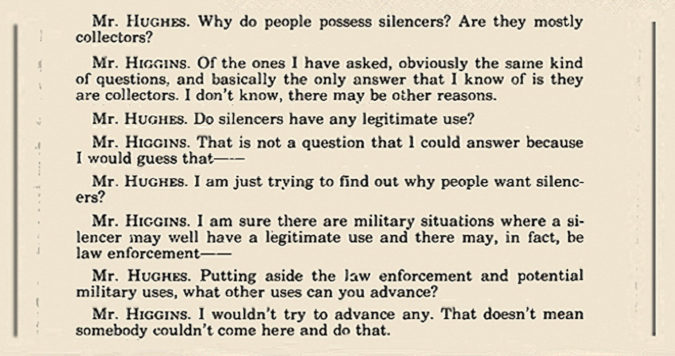
Today, a knowledgeable person might read these accounts with extreme frustration, wishing they were the “somebody” on-hand to “advance the legitimate uses” of silencers.
During this ignorant onslaught upon the suppressor, no one present was able to successfully advocate for them or highlight the millions of sportsmen and defensive users of firearms that suffer from hearing damage each year.
BATFE Director Higgins should have been aware of this by the 1980s, but in 1934, it was not known that hearing loss was a devastatingly widespread, preventable health concern. Attitudes toward hearing protection were different when the silencer was being demonized and these laws were being first written.
As a medical journal study explains the zeitgeist: “The pervasive attitude of the early 1900s was that hearing loss could be prevented by developing a tolerance to noise. Consequently, any attempts to avoid loud sounds or to protect oneself from them were interpreted as weakness.”
This “tolerance” theory was not scientifically studied until 1941, when the U.S. Army opened the Armored Medical Research Laboratory at Fort Knox, Kentucky.
This laboratory completed a landmark study in 1944, resulting in the recommendation (but not a requirement) that gun crews, gunnery instructors, and others regularly exposed to gunfire blasts be provided hearing-protective devices.
It would be 1978 when the first Department of Defense instructions were issued to establish a program with the goals of eliminating occupational noise-related hearing loss among DoD personnel (military and civilian) and reducing the costs of hearing damage compensation claims.
TRUTH FELL ON DEAF EARS
One hundred years ago, hearing protection was barely thought of, much less used. Men went deaf doing manly things, earplugs were for sissies, and that was just the way life in the early 1900s was viewed. Fears of crime — whether real or imagined — were informed and flavored by only a handful of actual incidents, and more by xenophobia and racism.
In the days of the Second Industrial Revolution, rapid advancements in science and technology that could be envisioned to potentially assist criminals were met with ignorant, quickly-passed laws.
Today, we know that firearm-mounted hearing protection benefits public health far more than it enables bad actors. Recent studies of federal prosecutions show that very few silencer “crimes” have been processed, and of those, “more than 80 percent of federal silencer charges are for non-violent, victimless crimes.”
Dave Kopel writes, “In other words, the possessor was not allowed to possess firearms, ammunition or silencers… but was not misusing the item. In only 2 percent of the cases was the firearm discharged. [A]nalysis of California cases from 2000-2005 found similar results. Thus, the misuse rate for lawfully purchased suppressors appears to be very low.”
If the laws of the 1900s were only based on the age’s ignorance of hearing damage and unawareness of human health, perhaps they might even be forgiven. But they were also strongly influenced by a movement to demonize an inanimate object instead of assigning blame to the criminal.
This emboldened a quickly corrupting government in its desire to over-tax and over-regulate anything new. These combined factors all led to the National Firearms Act of 1934 and the Gun Control Act of 1968 denying the silencer what should have been its rightful reputation: a commonsense muffler that can prevent hearing loss for millions of U.S. soldiers and citizens.

Today, most all of the U.S. states have ditched their antiquated anti-silencer laws as the health benefits of silencers are continually proven to outweigh fears of criminal use.
At this point, the outdated 1934 federal law stands almost alone in prohibiting a simple, century-old muffler.
Ready for more? Take a look:
- Suppressor Enhancement: Making A Can Quieter
- Suppressor Maintenance And Re-Coring With Curtis Tactical
- The Solvent Trap And The True DIY Suppressor: Titanium Dreams With The JK Armament SBR Pro
ABOUT THE AUTHOR
Kel Whelan is a consultant to industry and government on silencer business and technology with more than 20 years of experience in manufacturing, design, sales, distribution, branding, and politics throughout the NFA industry. By way of disclosure, he owned, managed, and sold a silencer company and was one of the three founding directors of the ASA.
